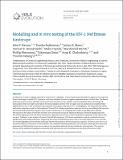| dc.contributor.author | Barton, John P | |
| dc.contributor.author | Rajkoomar, Erasha | |
| dc.contributor.author | Mann, Jaclyn K | |
| dc.contributor.author | Murakowski, Dariusz K | |
| dc.contributor.author | Toyoda, Mako | |
| dc.contributor.author | Mahiti, Macdonald | |
| dc.contributor.author | Mwimanzi, Phillip | |
| dc.contributor.author | Ueno, Takamasa | |
| dc.contributor.author | Chakraborty, Arup K | |
| dc.contributor.author | Ndung’u, Thumbi | |
| dc.date.accessioned | 2021-10-27T19:52:24Z | |
| dc.date.available | 2021-10-27T19:52:24Z | |
| dc.date.issued | 2019 | |
| dc.identifier.uri | https://hdl.handle.net/1721.1/133371 | |
| dc.description.abstract | An effective vaccine is urgently required to curb the HIV-1 epidemic. We have previously described an approach to model the fitness landscape of several HIV-1 proteins, and have validated the results against experimental and clinical data. The fitness landscape may be used to identify mutation patterns harmful to virus viability, and consequently inform the design of immunogens that can target such regions for immunological control. Here we apply such an analysis and complementary experiments to HIV-1 Nef, a multifunctional protein which plays a key role in HIV-1 pathogenesis. We measured Nef-driven replication capacities as well as Nef-mediated CD4 and HLA-I down-modulation capacities of thirty-Two different Nef mutants, and tested model predictions against these results. Furthermore, we evaluated the models using 448 patient-derived Nef sequences for which several Nef activities were previously measured. Model predictions correlated significantly with Nef-driven replication and CD4 down-modulation capacities, but not HLA-I down-modulation capacities, of the various Nef mutants. Similarly, in our analysis of patient-derived Nef sequences, CD4 down-modulation capacity correlated the most significantly with model predictions, suggesting that of the tested Nef functions, this is the most important in vivo. Overall, our results highlight how the fitness landscape inferred from patient-derived sequences captures, at least in part, the in vivo functional effects of mutations to Nef. However, the correlation between predictions of the fitness landscape and measured parameters of Nef function is not as accurate as the correlation observed in past studies for other proteins. This may be because of the additional complexity associated with inferring the cost of mutations on the diverse functions of Nef. | |
| dc.language.iso | en | |
| dc.publisher | Oxford University Press (OUP) | |
| dc.relation.isversionof | 10.1093/ve/vez029 | |
| dc.rights | Creative Commons Attribution 4.0 International license | |
| dc.rights.uri | https://creativecommons.org/licenses/by/4.0/ | |
| dc.source | Oxford University Press | |
| dc.title | Modelling and in vitro testing of the HIV-1 Nef fitness landscape | |
| dc.type | Article | |
| dc.contributor.department | Massachusetts Institute of Technology. Department of Chemical Engineering | |
| dc.contributor.department | Massachusetts Institute of Technology. Department of Physics | |
| dc.contributor.department | Massachusetts Institute of Technology. Department of Chemistry | |
| dc.contributor.department | Massachusetts Institute of Technology. Institute for Medical Engineering & Science | |
| dc.contributor.department | Ragon Institute of MGH, MIT and Harvard | |
| dc.relation.journal | Virus Evolution | |
| dc.eprint.version | Final published version | |
| dc.type.uri | http://purl.org/eprint/type/JournalArticle | |
| eprint.status | http://purl.org/eprint/status/PeerReviewed | |
| dc.date.updated | 2019-08-15T17:33:44Z | |
| dspace.orderedauthors | Barton, JP; Rajkoomar, E; Mann, JK; Murakowski, DK; Toyoda, M; Mahiti, M; Mwimanzi, P; Ueno, T; Chakraborty, AK; Ndung’u, T | |
| dspace.date.submission | 2019-08-15T17:33:45Z | |
| mit.journal.volume | 5 | |
| mit.journal.issue | 2 | |
| mit.metadata.status | Authority Work and Publication Information Needed | |
